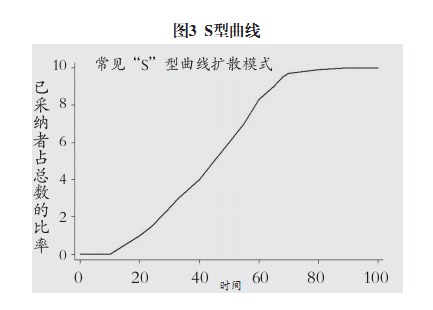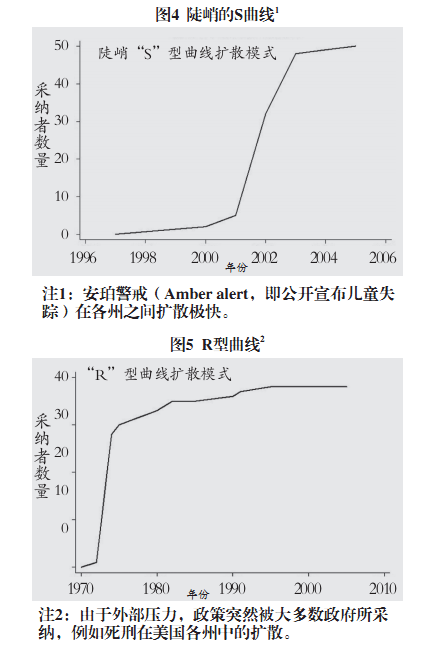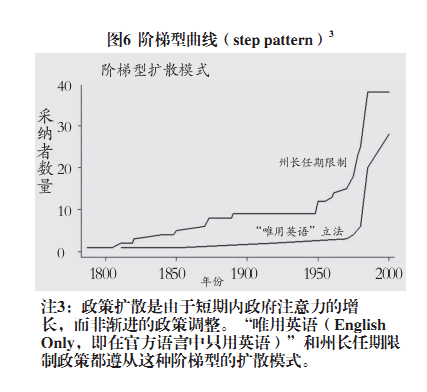地方政府创新扩散的机制与模式分析
创新扩散的机制。自20世纪60年代以来,研究者们对于政府的创新主要有两种解释。一种是内部决定模型,它假设引起一个政府创新的原因存在于这个政府所辖区域内部的客观条件之中,这些条件包括政治、经济、文化、社会特征和政府自身情况。另一种是外部影响模型,它指出了邻近政府或其他外部条件对这个政府的政策采纳情况的影响(Berry and Berry,1990)。但这两种解释都是较为片面的,随着实证资料的不断增多和研究方法的不断改进,人们通过对彩票政策(Berry and Berry,1990)、公共管理改革(Boyne et al.,2005)、空气政策(Dolsak and Sampson,2011)等领域的实证研究,不断发现政府辖区的内部条件和外部条件都会影响政府对政策的采纳。尽管如此,外部影响模型还是为政策扩散提供了最初的解释,并开政策扩散理论之先河。
所谓创新扩散的机制是指引起一项创新在不同政府之间扩散的原因和方式。在学者们尤为关注的外部影响(政策扩散)模型中,通常认为,政策扩散的机制至少包括学习、竞争、模仿和强制等(Shipan and Volden,2008)。学习机制假设政策制定者观察到诸多政策在其他政府中的影响后,决定是否分别采纳每项政策。由于政策制定者要学习外部经验,就必须借助一定的平台。因此研究者通常会将学习放在政策网络中研究(Mintrom and Vergari,1998;Linos,2006;FÜGlister,2012;Lee and Meene,2012;Mergel and Bretschneider,2013)。通常与学习机制一起被提出来的是竞争机制,它假设不同政府由于在经济、公共服务等方面的竞争而积极采纳或不采纳某项政策。例如,当竞争者通过加强基础设施建设以吸引外来投资时,那么本地政府为吸引外来投资,将不得不也采纳这些政策(Teodoro,2009)。模仿机制又被称为社会化机制,它主要指本地政府复制其他政府的行为。模仿与学习不同,在学习中,政策制定者关注的是政策本身(它是如何被采纳的?是否有效?政策后果如何?),而模仿关注的是其他政府(其他政府怎么做?我们如何和他们做的一样?)。换句话说,学习关注的是行动,模仿关注的是行动者。
如果是因外部行为体施压而采纳了某项政策,那么这就是由强制引起的扩散,它的形式主要包括武力、威胁或激励。虽然由于美国的联邦制度设计,让横向的强制在各州或地方政府之间受到限制,但纵向的强制机制仍旧存在。因为来自联邦政府的资金通常都会刺激各州或地方政府采纳某项政策(Allen et al.,2004;Karch,2007)。此外,纵向强制(Coercion)机制之下还包含一种较为突出的指令方式(mandate),它主要是指联邦政府出台法令政策或通过激励提出要求(Shipan and Volden,2006)。在当前的研究文献中,竞争机制与学习机制是最常见的被用来解释政策扩散过程的机制(Boehmke and Witmer,2004)。值得提出的是,还有学者将政策扩散的模型概括为全国互动模型、邻区扩散模型、领导跟进模型、垂直影响模型,或者将政策扩散的原因概括为四个方面:竞争、学习、命令和公共压力(公共压力也可以算是一种“社会化”过程,此时,社会压力使政府做出和外部一致的改变)(Berry and Berry,1999)。这与上述的政策扩散机制只是对同样现象的不同表述,因而都可以被归纳进学习、竞争、模仿和强制等四种机制中。
创新扩散的模式。创新扩散的模式是指一项创新在扩散过程中所表现的速度与规模的基本特征。对扩散模式的描述与研究有助于我们从整体上把握一项创新的扩散过程。许多学者都曾尝试对政府创新扩散的模式进行描述和模型化(Menzel and Feller,1977;Gray,1973;Berry and Berry,1999;Rogers,2003),并倾向于将政策扩散的过程看成是渐进的、符合正态分布的S型曲线扩散模式(即地方政府采纳时间的累计分布曲线)。即在扩散过程的早期,一项创新被采纳的频率并不频繁。伴随着时间的流逝,扩散频率会逐渐加速。但由于潜在采纳者的数额在快速减少,因而扩散频率会降下来直至整个创新扩散的过程实现饱和(如图3所示)。

然而,在现实中,许多政府创新扩散的实例并不完全遵从正态分布,且符合S型曲线。事实上,在不同的情境下,创新扩散模式会得到完全不同的展现。例如,在布什伊的书中,试图将传统理论所无法解释的政策扩散曲线划分为以下几类:比较陡峭的S曲线(如图4所示)、R型曲线(如图5所示)、阶梯模式(如图6所示)。他还举出了多个实例加以佐证,包括“安珀警戒”、死刑和语言政策等(Boushey,2010)。这些扩散模式的潜在机制与经典理论假设存在着明显的冲突。而与渐进主义相对立的“断点均衡(punctuated equilibrium)”理论或许有助于提供新的解释,例如政治注意力的不均衡变化或许直接决定了扩散速度的变化。遗憾的是,当前学者们对这些“断点式”扩散模式的具体机制研究还不深入。


结论
通过以上阐述,我们可以发现,学者们研究地方政府创新扩散主要是为了探究政策创新扩散的动机框架、机制和模式等。这对于政策实践与政策理论的发展都非常重要。尤其是对于中国而言,当前政策变迁频繁且影响深远,亟须通过理论研究来对地方政府创新和扩散过程提供理论解释。同时,也绝不能直接照搬西方的理论。本文认为,国内学界在研究中国地方政府的创新扩散现象时,至少应考虑以下内容:第一,积极把握理论发展的良好机遇。对于中国而言,当前政策变迁的深度、广度和频度都是非常大的,各地方的政策试验层出不穷。对于这些政策现象所处的环境、参与主体、政策本身特征以及政策过程等问题的研究有助于我们取得重大理论突破。第二,不能迷信西方经典理论。在用创新扩散理论来解释中国的政策现象时,要抓准突破口,并在此基础上敢于向既有的经典理论框架提出挑战。第三,国内学者也应加强与国外学者的方法接轨和理论对话。国内学者的现有研究在理论和方法上都与国际先进水平有一定差距。只有掌握规范的研究方法,与国际理论前沿积极对话,才能提升自身能力并提出令人信服的理论假设,从而实现本土化理论创新并掌握国际学术话语权。
(南开大学周恩来政府管理学院硕士研究生张友浪是本文的共同作者)
参考文献
Allen, Mahalley D., Carrie Pettus, and Donald P Haider-Markel. 2004. "Making the National Local: Specifying the Conditions for National Government Influence on State Policymaking." State Politics & Policy Quarterly 4 (3):318-44.
Aslani, Alireza, Marja Naaranoja, and Kau-Fui V. Wong. 2013. "Strategic Analysis of Diffusion of Renewable Energy in the Nordic Countries." Renewable and Sustainable Energy Reviews 22:497-505.
Bennett, Colin J. 1991. "What is Policy Convergence and What Causes It?" British Journal of Political Science:215-33.
Bennett, Colin J. 1997. "Understanding Ripple Effects: The Cross-National Adoption of Policy Instruments for Bureaucratic Accountability." Governance 10 (3):213-33.
Berry, Frances Stokes, and William D. Berry. 1990. "State Lottery Adoptions as Policy Innovations: An Event History Analysis." The American Political Science Review:395-415.
Berry, Frances Stokes, and William D. Berry. 1999. "Innovation and Diffusion Models in Policy Research." Theories of the Policy Process:169.
Boehmke, Frederick J., and Richard Witmer. 2004. "Disentangling Diffusion: The Effects of Social Learning and Economic Competition on State Policy Innovation and Expansion." Political Research Quarterly 57 (1):39-51.
Boushey, Graeme. 2010. Policy diffusion dynamics in America. Cambridge University Press.
Boyne, George A., Julian S Gould-Williams, Jennifer Law, and Richard M Walker. 2005. "Explaining the Adoption of Innovation: An Empirical Analysis of Public Management Reform." Environment and Planning C: Government & Policy 23 (3):419-35.
Braun, Dietmar, and Fabrizio Gilardi. 2006. "Taking 'Galton's Problem' Seriously Towards a Theory of Policy Diffusion." Journal of Theoretical Politics 18 (3):298-322.
Canon, Bradley C., and Lawrence Baum. 1981. "Patterns of Adoption of Tort Law Innovations: An Application of Diffusion Theory to Judicial Doctrines." The American Political Science Review:975-87.
Cao, Xun. 2009. "Networks of Intergovernmental Organizations and Convergence in Domestic Economic Policies." International Studies Quarterly 53 (4):1095-130.
Carter, Larry E., and James T. LaPlant. 1997. "Diffusion of Health Care Policy Innovation in the United States." State & Local Government Review:17-26.
Damanpour, Fariborz, and William M. Evan. 1984. "Organizational Innovation and Performance: the Problem of 'Organizational Lag'." Administrative Science Quarterly:392-409.
Dobbin, Frank, Beth Simmons, and Geoffrey Garrett. 2007. "The Global Diffusion of Public Policies: Social Construction, Coercion, Competition, or Learning?" Annu. Rev. Sociol. 33:449-72.
Dolowitz, David, and David Marsh. 1996. "Who Learns What from Whom: A Review of the Policy Transfer Literature." Political Studies 44 (2):343-57.
Dolsak, N., and K. Sampson. 2011. "The Diffusion of Market-Based Instruments: The Case of Air Pollution." Administration & Society 44 (3):310-42.
FÜGlister, Katharina. 2012. "Where does Learning Take Place? The Role of Intergovernmental Cooperation in Policy Diffusion." European Journal of Political Research 51 (3):316-49.
Graham, Erin R., Charles R. Shipan, and Craig Volden. 2012. "The Diffusion of Policy Diffusion Research in Political Science." British Journal of Political Science 43 (03):673-701.
Gray, Virginia. 1973. "Innovation in the States: A Diffusion Study." The American Political Science Review 67 (4):1174-85.
Grupp, Fred W., and Alan R Richards. 1975. "Variations in Elite Perceptions of American States as Referents for Public Policy making." The American Political Science Review:850-8.
Hays, Scott P. 1996. "Patterns of Reinvention." Policy Studies Journal 24 (4):551-66.
Heiden, Nico, and Felix Strebel. 2012. "What about Non-diffusion? The Effect of Competitiveness in Policy-comparative Diffusion Research." Policy Sciences 45 (4):345-58.
Heilmann, Sebastian. 2008a. "From Local Experiments to National Policy: The Origins of China's Distinctive Policy Process." The China Journal (59):1-30.
Heilmann, Sebastian. 2008b. "Policy Experimentation in China's Economic Rise." Studies in Comparative International Development 43 (1):1-26.
Karch, Andrew. 2007. Democratic Laboratories: Policy Diffusion among the American States: University of Michigan Press.
Kimberly, John R., and Michael J Evanisko. 1981. "Organizational Innovation: The Influence of Individual, Organizational, and ContextualFactors on Hospital Adoption of Technological and Administrative Innovations." Academy of Management Journal 24 (4):689-713.
Kingdon, John. 1984. Agendas, Alternatives and Public Choices. Boston: Little, Brown.
Lee, Taedong, and Susan Meene. 2012. "Who Teaches and Who Learns? Policy Learning through the C40 Cities Climate Network." Policy Sciences 45 (3):199-220.
Light, Paul Charles, and Paul C Light. 1998. Sustaining Innovation: Creating Nonprofit and Government Organizations that Innovate Naturally: Jossey-Bass San Francisco.
Linos, Katerina. 2006. "When Do Policy Innovations Spread? Lessons for Advocates of Lesson-Drawing." Harvard Law Review 119:1467.
Makse, Todd, and Craig Volden. 2011. "The Role of Policy Attributes in the Diffusion of Innovations." The Journal of Politics 73 (1):108-24.
Menzel, Donald C., and Irwin Feller. 1977. "Leadership and Interaction Patterns in the Diffusion of Innovations among the American States." Political Research Quarterly 30 (4):528-36.
Mergel, Ines, and Stuart I. Bretschneider. 2013. "A Three-Stage Adoption Process for Social Media Use in Government." Public Administration Review 73 (3):390-400.
Meseguer, C. 2005. "Policy Learning, Policy Diffusion, and the Making of a New Order." The ANNALS of the American Academy of Political and Social Science 598 (1):67-82.
Mintrom, Michael. 1997. "Policy Entrepreneurs and the Diffusion of Innovation." American Journal of Political Science:738-70.
Mintrom, Michael, and Sandra Vergari. 1998. "Policy Networks and Innovation Diffusion: The Case of State Education Reforms." The Journal of Politics 60 (01):126-48.
Mitchell, James Clyde. 1969. Social Networks in Urban Situations: Analyses of Personal Relationships in Central African Towns. Manchester University Press.
Mooney, Christopher Z., and Mei-Hsien Lee. 1999. "Morality Policy Reinvention: State Death Penalties." The ANNALS of the American Academy of Political and Social Science 566 (1):80-92.
Nicholson-Crotty, Sean. 2009. "The Politics of Diffusion: Public Policy in the American States." The Journal of Politics 71 (01):192.
Osborne, S. P., Z. Radnor, and G. Nasi. 2012. "A New Theory for Public Service Management? Toward a (Public) Service-Dominant Approach." The American Review of Public Administration 43 (2):135-58.
Rogers, Everett. 2003. Diffusion of Innovations. New York: Free Press.
Sager, Fritz, and Yvan Rielle. 2012. "Sorting through the Garbage Can: Under What Conditions do Governments Adopt Policy Programs?" Policy Sciences 46 (1):1-21.
Savage, Robert L. 1978. "Policy Innovativeness as a Trait of American States." The Journal of Politics 40 (01):212-24.
Savage, Robert L. 1985. "When a Policy's Time Has Come: Cases of Rapid Policy Diffusion 1983-1984." Publius: The Journal of Federalism 15 (3):111-26.
Schmitt, Carina. 2011. "What Drives the Diffusion of Privatization Policy? Evidence from the Telecommunications Sector." Journal of Public Policy 31 (01):95-117.
Shaoguang, Wang. 2009. "Adapting by Learning: The Evolution of China's Rural Health Care Financing." Modern China 35 (4):370-404.
Shipan, Charles R., and Craig Volden. 2006. "Bottom-Up Federalism: The Diffusion of Antismoking Policies from US Cities to States." American journal of political science 50 (4):825-43.
Shipan, Charles R., and Craig Volden. 2008. "The Mechanisms of Policy Diffusion." American Journal of Political Science 52 (4):840-57.
Teodoro, M. P. 2009. "Contingent Professionalism: Bureaucratic Mobility and the Adoption of Water Conservation Rates." Journal of Public Administration Research and Theory 20 (2):437-59.
True, Jacqui, and Michael Mintrom. 2001. "Transnational Networks and Policy Diffusion: The Case of Gender Mainstreaming." International Studies Quarterly 45 (1):27-57.
Truman, David Bicknell. 1951. The Governmental Process. New York: Knopf.
Tyran, Jean-Robert, and Rupert Sausgruber. 2005. "The Diffusion of Policy Innovations -An Experimental Investigation." Journal of Evolutionary Economics 15 (4):423-42.
Valente, Thomas W. 1996. "Social Network Thresholds in the Diffusion of Innovations." Social Networks 18 (1):69-89.
Volden, Craig. 2006. "States as Policy Laboratories: Emulating Success in the Children's Health Insurance Program." American Journal of Political Science 50 (2):294-312.
Walker, Jack L. 1969. "The Diffusion of Innovations among the American States." The American Political Science Review 63 (3):880-99.
Walker, Richard M., Emma Jeanes, and Robert Rowlands. 2002. "Measuring Innovation-Applying the Literature‐Based Innovation Output Indicator to Public Services." Public Administration 80 (1):201-14.
Wasserman, Stanley. 1994. Social Network Analysis: Methods and Applications. Vol. 8. Cambridge university press.
Zhu, Xufeng. 2008. "Strategy of Chinese Policy Entrepreneurs in the Third Sector: Challenges of ' Technical Infeasibility'." Policy Sciences 41 (4):315-34.
Zhu, Xufeng. 2013. "Mandate Versus Championship: Vertical Government Intervention and Diffusion of Innovation in Public Services in Authoritarian China." Public Management Review (ahead-of-print):1-23.
【作者简介】
朱旭峰,清华大学公共管理学院教授、博导。研究方向为政策过程理论、思想库与专家参与、转型与公共治理。主要著作有《The Rise of Think Tanks in China》、《政策变迁中的专家参与》、《中国思想库》等。
Difficulty in Promoting the Innovation Experience of Local Government
—Review of the Research on the Public Policy Innovation Diffusion Theory
Zhu Xufeng
Abstract: Research on the local government’s innovation diffusion is mainly intended to explore the motivation framework, mechanism and mode of policy innovation diffusion. It is very important for the development of policy practice and policy theory. Especially in China, current policy changes are frequent and have far-reaching influence, and theoretical research is urgently needed to interpret the diffusion process of local government’s innovation. However, directly copying the Western theory is not desirable. At present, Chinese local governments are conducting policy experiments one after another. Researching the environment for these policy phenomena, people participated, their characteristics and policy implementation process will help scholars to make a major theoretical breakthrough. On the basis of this, scholars can challenge the existing classical theoretical framework. Only by grasping the standard research method and having dialogue with the international frontier theory can we enhance our own abilities and put forward convincing theoretical hypothesis, so as to realize the localized theoretical innovation and have international academic discourse power.
Keywords: local government, innovation diffusion, relationship between the central and local government, public administration, deepening reform comprehensively
